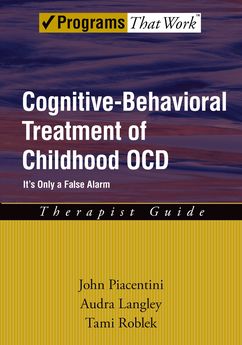Obsessive Compulsive Disorder (OCD) affects an estimated 2% of children in the United States and can cause considerable anxiety. OCD is characterized by a pattern of rituals (or compulsions) and obsessive thinking. Common obsessions among children and teens include a fear of dirt or germs, a need for symmetry, order, and precision, and a fear of illness or harm coming to oneself or relatives. Common compulsions include grooming, repeating, and cleaning rituals. These obsessions and compulsions can severely interfere with daily functioning and are a source of significant distress. Without adequate treatment, the quality of life for youths and families
dealing with OCD often suffers.
Cognitive-Behavioral Therapy (CBT) has shown to be effective in the treatment of childhood OCD. This Therapist Guide outlines a 12-session CBT-based treatment for OCD that benefits not only children and adolescents, but their families as well. Each session incorporates a family therapy component in addition to individual treatment for the child. It is a combined approach program that educates the child and family about OCD in order to reduce negative feelings of guilt and blame and to normalize family functioning. This manual also provides guidelines for conducting both imaginal and in vivo exposures; techniques at the core of helping children reduce their anxiety. For use with
children ages 8 17, this book is an indispensable resource for clinicians helping children and their families cope with OCD.
Features
- Selling point: -Part of the successful TreatmentsThatWork series
- Selling point: -Written by the developers of the treatment
- Selling point: -Comprehensive treatment that involves both children and their families
1Introductory Information for Therapists
2Session 1
3Session 2
4Session 3
5Session 4
6Session 5
7Session 6
8Session 7
9Session 8
10Session 9
11Session 10
12Session 11
13Session 12
Mental health professionals who treat Obsessive-Compulsive Disorder (OCD) in kids.; Graduate students.
